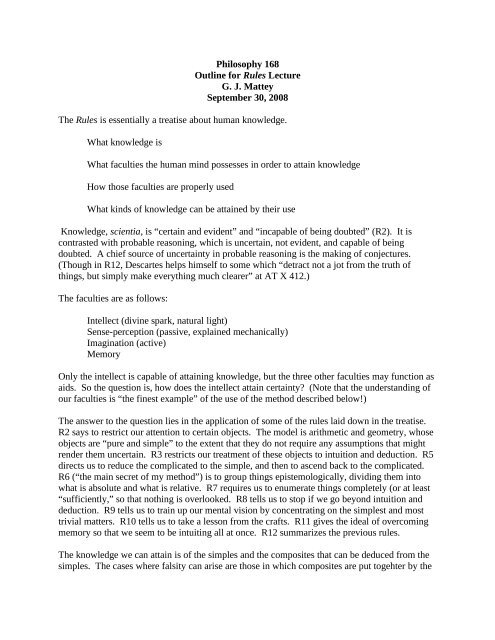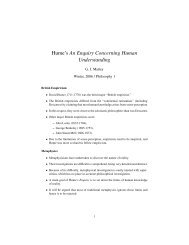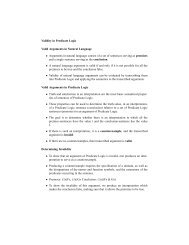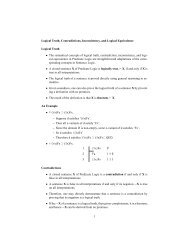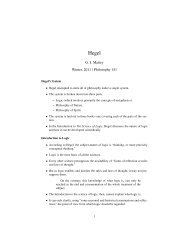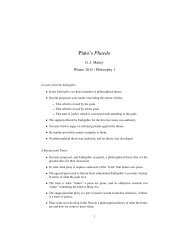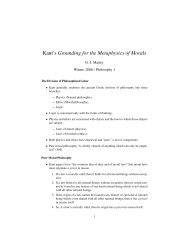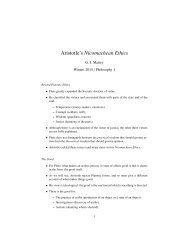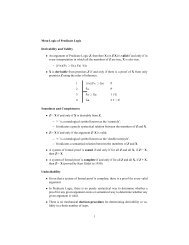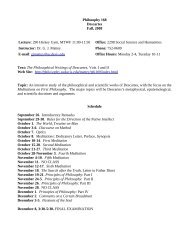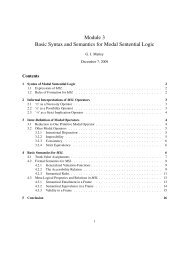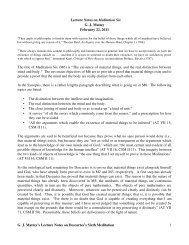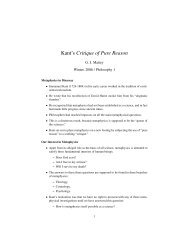Philosophy 168 Outline for Rules Lecture G. J. Mattey September 30 ...
Philosophy 168 Outline for Rules Lecture G. J. Mattey September 30 ...
Philosophy 168 Outline for Rules Lecture G. J. Mattey September 30 ...
You also want an ePaper? Increase the reach of your titles
YUMPU automatically turns print PDFs into web optimized ePapers that Google loves.
<strong>Philosophy</strong> <strong>168</strong><br />
<strong>Outline</strong> <strong>for</strong> <strong>Rules</strong> <strong>Lecture</strong><br />
G. J. <strong>Mattey</strong><br />
<strong>September</strong> <strong>30</strong>, 2008<br />
The <strong>Rules</strong> is essentially a treatise about human knowledge.<br />
What knowledge is<br />
What faculties the human mind possesses in order to attain knowledge<br />
How those faculties are properly used<br />
What kinds of knowledge can be attained by their use<br />
Knowledge, scientia, is “certain and evident” and “incapable of being doubted” (R2). It is<br />
contrasted with probable reasoning, which is uncertain, not evident, and capable of being<br />
doubted. A chief source of uncertainty in probable reasoning is the making of conjectures.<br />
(Though in R12, Descartes helps himself to some which “detract not a jot from the truth of<br />
things, but simply make everything much clearer” at AT X 412.)<br />
The faculties are as follows:<br />
Intellect (divine spark, natural light)<br />
Sense-perception (passive, explained mechanically)<br />
Imagination (active)<br />
Memory<br />
Only the intellect is capable of attaining knowledge, but the three other faculties may function as<br />
aids. So the question is, how does the intellect attain certainty? (Note that the understanding of<br />
our faculties is “the finest example” of the use of the method described below!)<br />
The answer to the question lies in the application of some of the rules laid down in the treatise.<br />
R2 says to restrict our attention to certain objects. The model is arithmetic and geometry, whose<br />
objects are “pure and simple” to the extent that they do not require any assumptions that might<br />
render them uncertain. R3 restricts our treatment of these objects to intuition and deduction. R5<br />
directs us to reduce the complicated to the simple, and then to ascend back to the complicated.<br />
R6 (“the main secret of my method”) is to group things epistemologically, dividing them into<br />
what is absolute and what is relative. R7 requires us to enumerate things completely (or at least<br />
“sufficiently,” so that nothing is overlooked. R8 tells us to stop if we go beyond intuition and<br />
deduction. R9 tells us to train up our mental vision by concentrating on the simplest and most<br />
trivial matters. R10 tells us to take a lesson from the crafts. R11 gives the ideal of overcoming<br />
memory so that we seem to be intuiting all at once. R12 summarizes the previous rules.<br />
The knowledge we can attain is of the simples and the composites that can be deduced from the<br />
simples. The cases where falsity can arise are those in which composites are put togehter by the
intellect. R13-R24 deals with cases where the composites are deduced from the simples, and<br />
R25-36 were supposed to deal with cases where the composites presuppose other natures “which<br />
experience shows to be composite in reality” (AT X 399). In the <strong>for</strong>mer case, we reduce our<br />
problems to graphical representations and try to solve <strong>for</strong> unknown quantities, using primarily<br />
addition and subtraction. The paradigm case is addition.<br />
In R12, Descartes describes modes of being which requires only having rationality to recognize.<br />
These may be purely intellectual, bodily, or a composite. Experience does not deceive so long as<br />
we take it as it presents itself, but it does deceive if we go beyond it to things, due to the<br />
corruption that is due to composition.


